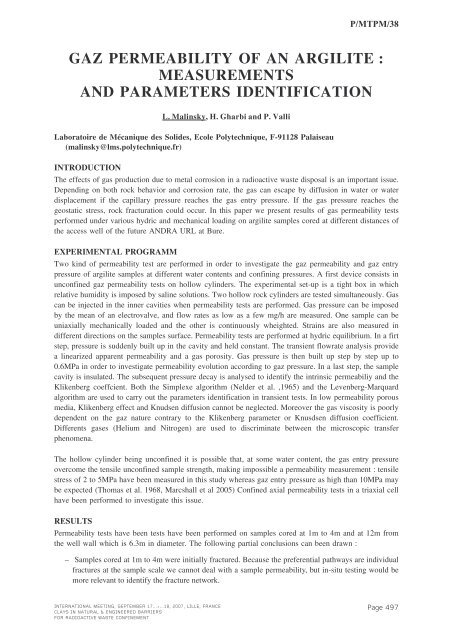Mass Transfer & Porous Media (MTPM) - Andra
Mass Transfer & Porous Media (MTPM) - Andra
Mass Transfer & Porous Media (MTPM) - Andra
You also want an ePaper? Increase the reach of your titles
YUMPU automatically turns print PDFs into web optimized ePapers that Google loves.
P/<strong>MTPM</strong>/38GAZ PERMEABILITY OF AN ARGILITE :MEASUREMENTSAND PARAMETERS IDENTIFICATIONL. Malinsky , H. Gharbi and P. ValliLaboratoire de Mécanique des Solides, Ecole Polytechnique, F-91128 Palaiseau(malinsky@lms.polytechnique.fr)INTRODUCTIONThe effects of gas production due to metal corrosion in a radioactive waste disposal is an important issue.Depending on both rock behavior and corrosion rate, the gas can escape by diffusion in water or waterdisplacement if the capillary pressure reaches the gas entry pressure. If the gas pressure reaches thegeostatic stress, rock fracturation could occur. In this paper we present results of gas permeability testsperformed under various hydric and mechanical loading on argilite samples cored at different distances ofthe access well of the future ANDRA URL at Bure.EXPERIMENTAL PROGRAMMTwo kind of permeability test are performed in order to investigate the gaz permeability and gaz entrypressure of argilite samples at different water contents and confining pressures. A first device consists inunconfined gaz permeability tests on hollow cylinders. The experimental set-up is a tight box in whichrelative humidity is imposed by saline solutions. Two hollow rock cylinders are tested simultaneously. Gascan be injected in the inner cavities when permeability tests are performed. Gas pressure can be imposedby the mean of an electrovalve, and flow rates as low as a few mg/h are measured. One sample can beuniaxially mechanically loaded and the other is continuously wheighted. Strains are also measured indifferent directions on the samples surface. Permeability tests are performed at hydric equilibrium. In a firtstep, pressure is suddenly built up in the cavity and held constant. The transient flowrate analysis providea linearized apparent permeability and a gas porosity. Gas pressure is then built up step by step up to0.6MPa in order to investigate permeability evolution according to gaz pressure. In a last step, the samplecavity is insulated. The subsequent pressure decay is analysed to identify the intrinsic permeabiliy and theKlikenberg coeffcient. Both the Simplexe algorithm (Nelder et al. ,1965) and the Levenberg-Marquardalgorithm are used to carry out the parameters identification in transient tests. In low permeability porousmedia, Klikenberg effect and Knudsen diffusion cannot be neglected. Moreover the gas viscosity is poorlydependent on the gaz nature contrary to the Klikenberg parameter or Knusdsen diffusion coefficient.Differents gases (Helium and Nitrogen) are used to discriminate between the microscopic transferphenomena.The hollow cylinder being unconfined it is possible that, at some water content, the gas entry pressureovercome the tensile unconfined sample strength, making impossible a permeability measurement : tensilestress of 2 to 5MPa have been measured in this study whereas gaz entry pressure as high than 10MPa maybe expected (Thomas et al. 1968, Marcshall et al 2005) Confined axial permeability tests in a triaxial cellhave been performed to investigate this issue.RESULTSPermeability tests have been tests have been performed on samples cored at 1m to 4m and at 12m fromthe well wall which is 6.3m in diameter. The following partial conclusions can been drawn :– Samples cored at 1m to 4m were initially fractured. Because the preferential pathways are individualfractures at the sample scale we cannot deal with a sample permeability, but in-situ testing would bemore relevant to identify the fracture network.INTERNATIONAL MEETING, SEPTEMBER 17...>...18, 2007, LILLE, FRANCECLAYS IN NATURAL & ENGINEERED BARRIERSFOR RADIOACTIVE WASTE CONFINEMENTPage 497
















